Posts by: Tushna Commissariat
Juggling Newton’s cradles, physics poetry, the birth of exoplanetary research and more
By Tushna Commissariat
We get many exciting, interesting and sometimes strange e-mails in our Physics World inbox on a weekly basis. But we were pleasantly surprised to receive one from Jay Gilligan – a professor of juggling at the University of Dance and Circus in Stockholm, Sweden. Together with one of his former students, Erik Åberg, he has perfected the art of juggling with giant Newton’s cradles. While juggling undoubtedly involves a lot of physics – everything from air resistance, speed, velocity and of course gravity comes into play – this takes it to an even more physical, if you will excuse the pun, level. Do watch the video above to see all of the amazing tricks that the duo can do, and try them for yourself if you are dexterous enough.
Weighing up the options for neutrino mass
By Tushna Commissariat
As I am sure all of you know, the 2015 Nobel Prize for Physics was awarded yesterday to Arthur McDonald and Takaaki Kajita “for the discovery of neutrino oscillations, which shows that neutrinos have mass”. Following on from yesterday’s neutrino-flavoured excitement, here’s an explanation of why it’s so important that we better understand neutrino mass.
Our current observations and theories of neutrino oscillations suggest that at least two of the currently known three flavours of neutrinos have non-zero mass. While we know the mass differences between the different neutrino flavours accurately, their actual masses have not been measured. It’s not for lack of trying, it has simply proven very difficult to make the measurements.
View all posts by this author | View this author's profile
Blood Moon at night, stargazers’ delight
By Tushna Commissariat
I am rather tired as I type up this post, but I do have an excellent excuse for being so sleepy today as I was awake until the wee hours of the morning watching the “super blood Moon” eclipse. As most of you know, today’s eclipse was particularly impressive as a super Moon (when the Moon is at its closest point to the Earth) coincided with a total lunar eclipse – when the Earth is perfectly in-between the Sun and Moon.
Rather unusually for the UK, we (in and around Bristol, at least) had a crystal-clear night, devoid of any clouds. I set up camp in my backyard, armed with a pair of binoculars, my camera with a zoom lens (but, unfortunately, no tripod) and a hot cup of tea…or two!
Despite the cold bite of an autumn night, the Moon really was a sight to behold. Before the eclipse, the super Moon was so bright that I could hardly look at it through my binoculars.

The full “super Moon” at around 10 p.m. BST, a few hours before the eclipse began. (Courtesy: Graeme Watt)
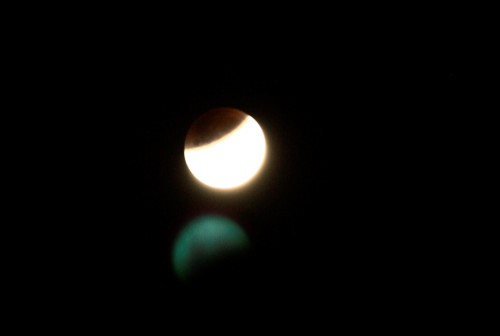
The Moon partially eclipsed, not quite bloody just yet, with a lunar flare. (Courtesy: Tushna Commissariat)
View all posts by this author | View this author's profile
Our true place in the universe, an eclipse for insomniacs and how far the Chilean landmass moved last week
By Tushna Commissariat
An image of the solar system – showing our luminous Sun ringed by nine (or is it eight?) evenly spaced planets and the asteroid belt – is a familiar feature in many school textbooks. In fact, such images are so commonplace that we often forget just how wrong they are when it comes to showing the true scale of the solar system. In particular, the billions and billions of kilometres of empty space that lie between each planet are rarely depicted.
Now, filmmakers and friends Wylie Overstreet and Alex Gorosh have “drawn” a realistic model of the solar system on a dry Nevada lakebed, complete with planetary orbits. The duo describes it as “a true illustration of our place in the universe”. Watch the video above to see how the pair planned and executed their massive portrait.
View all posts by this author | View this author's profile
Black-hole Sun, ticking clocks, coffee-stain avalanches and more
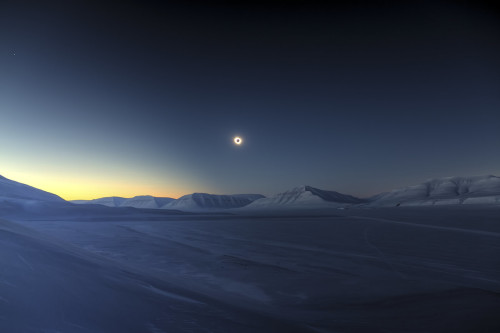
“Eclipse Totality over Sassendalen” by Luc Jamet.
(Courtesy: Luc Jamet/RAS)
By Michael Banks and Tushna Commissariat
It’s that time of the year again when the Royal Observatory Greenwich announces the winners of its Astronomy Photographer of the Year award and releases some of the most wonderful and awe-inspiring celestial images. Pictured above is this year’s overall winning image – titled “Eclipse Totality over Sassendalen” and taken by French photographer Luc Jamet, this stunning skyscape was taken from Svalbard during the total solar eclipse that took place earlier this year. “It is one of those heart-stoppingly beautiful shots for which you feel grateful to the photographer for sharing such an exceptional moment,” says Melanie Vandenbrouck, who was one of the judges. If you are in London, then you can drop in to the observatory to see the full exhibition , which opens today, and you can see all the winning images online.
While you’re admiring pictures, do take a look at the latest images of Pluto – backlit by the Sun and showing off its many rugged mountains and icy planes – taken by the New Horizons probe. The pictures are eerily similar to something you would see at the poles of our very own planet, while still maintaining its alien air.
Dismaland physics, laboratory photowalks and more
By James Dacey and Tushna Commissariat
While it may seem as if we Physics World journalists spend our evenings leafing through Newton’s Principia Mathematica or deriving the Dirac equation from first principles, on Wednesday night this week, a few of us visited Dismaland – the pop-up “bemusement park” curated by the elusive British street artist Banksy. Located in the seaside town of Weston-super-Mare – a few miles south-west of the Physics World Bristol HQ – Dismaland offers a darker and more politically motivated alternative to Mickey Mouse and his friends. While our visit was not work-related, there were a few unexpected physics references that we couldn’t help but spot. First we stumbled across “The Astronauts’ Caravan”, a humorous take on the flight simulators used by NASA (see video above).
Created in 2011 by artists and engineers Tim Hunkin and Andy Plant, the outwardly unimpressive-looking theme-park ride is a compact version of the Victorian “haunted swing” illusion. We won’t spoil the magic by explaining the mechanics of the ride here, but you can read this blog by Hunkin where he explains exactly how he and Plant built their spinning caravan and if you can’t visit Dismaland, then watch the video to see what it looks like from the inside.
View all posts by this author | View this author's profile
Moving meridians, Stradivarius violins, sunspots and more
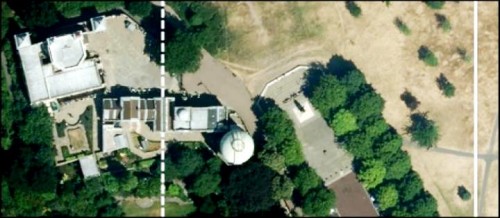
Walk the line: Airy meridian is marked as the “Prime Meridian of the World” (dotted line), and the modern reference meridian indicating zero longitude using GPS (solid line).
(Courtesy: 2014 Google Maps, Infoterra & Bluesky)
By Tushna Commissariat
A visit to the Royal Observatory in Greenwich is incomplete without walking along the Prime Meridian of the world – the line that literally divides the east from the west – and taking some silly photos across it. But you may be disappointed to know that the actual 0° longitudinal line is nearly 100 m away, towards the east, from the plotted meridian. Indeed, your GPS would readily show you that the line actually cuts through the large park ahead of the observatory. I, for one, am impressed that the original line is off by only 100 m, considering that it was plotted in 1884. A recently published paper in the Journal of Geodesy points out that with the extreme accuracy of modern technology like GPS, which has replaced the traditional telescopic observations used to measure the Earth’s rotation, we can measure this difference. You can read more about it in this article in the Independent.
View all posts by this author | View this author's profile
Former Indian president APJ Abdul Kalam was a ‘scientist and a statesman’
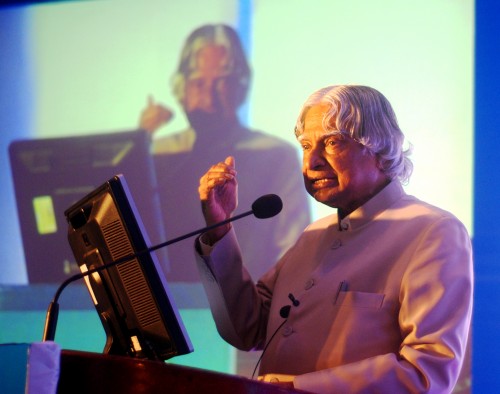
Missile Man: APJ Abdul Kalam delivering a speech in 2010.
(CC BY 3.0/Pushrakv)
By Tushna Commissariat
This week, India is mourning the loss of an esteemed leader – the country’s 11th president APJ Abdul Kalam, who died on Monday. Kalam was in office from 2002 to 2007 and enjoyed country-wide popularity, even post his presidency. Described by US president Barack Obama as a “scientist and a statesman” in his eulogy, Kalam was a physicist and an aeronautical engineer before he turned to politics, first acting as a science administrator and adviser for nearly four decades before his office run. Indeed, he was heavily involved in India’s nuclear tests and its military missile programme, earning him the moniker of “Missile Man”. In 2007 he was awarded the Royal Society’s King Charles II Medal, which is “awarded to foreign heads of state or government who have made an outstanding contribution to furthering scientific research in their country”.
View all posts by this author | View this author's profile
Balancing bicycles, looking back on Trinity, pricing up Pluto and more
By Tushna Commissariat
Mechanics was never my favourite topic when I was studying physics for my BSc, but I think I might have been more interested if we had looked at real-world situations rather than square blocks sliding down an incline plane. A bicycle that carries on, sans rider, without toppling over for quite a long time, for example, would have got my attention. This is a rather well-known quirk of mechanics though and it isn’t even the first time we have discussed it on the blog. Indeed, Physics World‘s James Dacey, a keen cyclist, delved into the topic in 2011. This week, we spotted a a new Minute Physics video on the subject, over at ZapperZ’s Physics and Physicists blog. Watch the video to get a good, if a tiny bit rushed, explanation of the three forces that come into play to allow a bicycle at a certain speed to zip along without its human companion. As the video suggests, all is not known about the secrets of free-wheeling bicycles just yet though, and I have a feeling that we will blog about it again in the years to come.
View all posts by this author | View this author's profile
Pluto fly-by: New Horizons sails past cold, distant world
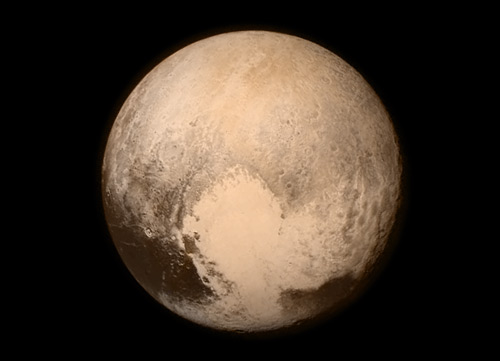
Perfect view: the sharpest image of Pluto to date taken by the New Horizons spacecraft. (Courtesy: NASA)
By Tushna Commissariat
After trundling through our solar system for more than 10 years, NASA’s New Horizons mission made its closest approach to the dwarf planet Pluto earlier today, at 12:49 BST. It was a mere 12,472 km from the planet’s surface – roughly the same distance from New York to Mumbai, India – making it the first-ever space mission to explore a world so far from Earth.
If you want to find out more about the New Horizons mission, read this recent news story by physicsworld.com editor Hamish Johnston. Above is best close-up view of this cold, unexplored world that the spacecraft sent back before its closest approach (when it was still 766,000 km from the surface), revealing in clear detail many of the planet’s surface features, including the “heart” at the bottom.
View all posts by this author | View this author's profile